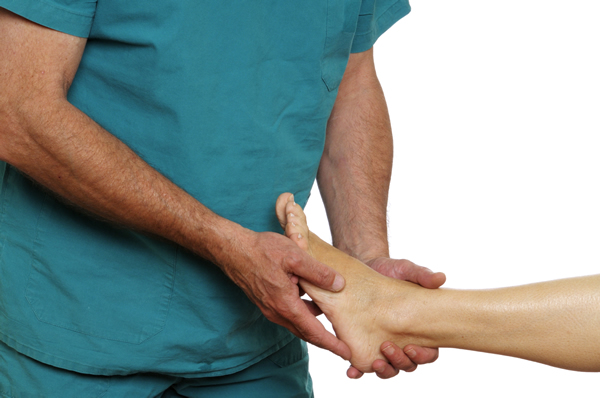 A hammertoe is a condition that impacts one of the middle toes and causes the toe to bend upward at its middle joint. Sometimes, hammertoe can be treated with lifestyle changes. But if hammertoe pain persists for an extended period of time, hammertoe correction surgery may prove to be ideal.
A hammertoe is a condition that impacts one of the middle toes and causes the toe to bend upward at its middle joint. Sometimes, hammertoe can be treated with lifestyle changes. But if hammertoe pain persists for an extended period of time, hammertoe correction surgery may prove to be ideal.
If you’re suffering from hammertoe, you may experience pain or imbalance when walking or performing other activities. This is where the board-certified podiatrists at La Peer Health Systems can help. Our Podiatry Department is happy to help you identify and treat hammertoe and avoid long-term toe and foot pain.
What Is a Hammertoe?
A hammertoe is a deformity of the foot in which an enlarged middle toe joint causes the toe to bend in a downward direction. It is called hammertoe because the bent toe often resembles a hammer. Hammertoe also impacts the toe’s appearance. As hammertoe worsens, the middle toe joint can enlarge further, stiffening as it comes into contact with the shoe.
Anatomy of a Hammertoe
The toe includes two joints that enable it to bend at the middle and bottom. A hammertoe occurs when the toe’s middle joint is flexed or bent downward.
Hammertoe causes progressive proximal interphalangeal (PIP) joint flexion deformity, resulting in compensatory hyperextension of the metatarsophalangeal (MTP) and distal interphalangeal (DIP) joints. The hyperextended MTP and DIP joints make the PIP joint prominent dorsally, causing the PIP joint to rub against the shoe.
There are two types of hammertoes: flexible and rigid. If an individual experiences flexible hammertoe, he or she can still move the toe joint. Comparatively, rigid hammertoe causes the toe tendons to become stiff and rigid and moves the toe joints out of alignment.
Hammertoe Symptoms
Hammertoe causes an irregular bend of one or more of the toe joints, which makes it difficult to move the toe. Also, hammertoe may result in toe and foot pain, as well as corns and calluses that form due to the toe rubbing against the inside of the shoe.
What Causes Hammertoe?
Common causes of hammertoe include:
- Arthritis
- Bunion pressure that causes the big toe to point inward toward the second toe
- High foot arch
- Ligaments or tendons in the foot that are tight
- Wearing shoes that do not fit properly
- Spinal cord or nerve damage
- Toe injury
There is no surefire cause of all hammertoe cases. As such, it is important to see a skilled podiatrist for proper diagnosis and treatment of this condition.
Hammertoe Surgery Before and After
La Peer Health System’s Podiatry Department has helped many hammertoe patients achieve their desired results. Check out our hammertoe surgery before and after photos to see how patients have benefited from our hammertoe treatments.
Hammertoe Surgery
The goal of hammertoe surgery is to help an individual correct toe and foot pain. If an individual has undergone non-operative treatments but continues to experience toe and foot pain and/or cannot wear shoes comfortably, he or she may be an ideal candidate for hammertoe correction.
Hammertoe can be treated with a simple outpatient surgical procedure. The surgeon will relax the tissue of the foot and help reposition the toes to a more normal setting. This procedure can relieve the pain and unsightly appearance associated with hammertoe and enable a patient to return to normal activity the same day.
Complications of Hammertoe Surgery
There is a risk of complications with all surgeries, and hammertoe correction surgery is no exception. Hammertoe surgery complications include:
- Bad reaction to anesthesia
- Bleeding and/or blood clot formation
- Nerve damage
- Swelling
Individuals who are experiencing multiple foot problems in conjunction with hammertoe should avoid surgery. Additionally, those who are dealing with active infections, poor circulation or other serious illnesses should consult with an orthopedic surgeon before treatment. An orthopedic surgeon will review a patient’s health history prior to hammertoe correction surgery, as well as discuss the risks and benefits associated with the procedure.
What to Expect After Hammertoe Surgery
Hammertoe surgery is an outpatient procedure with a fast recovery rate. Most patients can walk again on the same day they have surgery with the aid of a protective boot. Pain from hammertoe surgery is usually minimal and lasts between 48 and 72 hours, and most patients tolerate it well with the help of over-the-counter pain medications.
Full hammertoe surgery recovery requires several weeks. In some instances, patients may need a special shoe and/or crutches to help them maintain balance when they walk during the recovery period. Furthermore, patients should try to keep the foot elevated as much as possible in the first few weeks after surgery. This helps alleviate pressure from the foot and toe and allows these areas to heal.
Contact a Surgeon at La Peer Health Systems Today!
At La Peer Health System’s Podiatry Department, we employ a highly experienced team of doctors and nurses to help with all your foot health needs and are widely regarded as one of the best foot surgery centers in the country. Please feel free to contact our Podiatry Department at 855-360-9119 or by email at [email protected] to find out the La Peer difference firsthand!
Next, read about Bunion Surgery.
